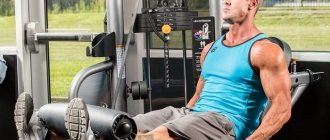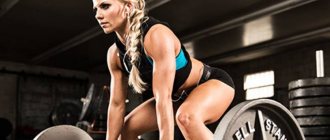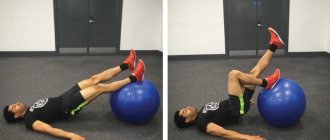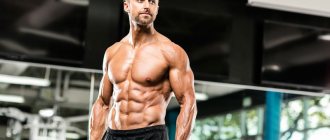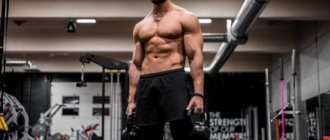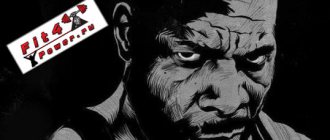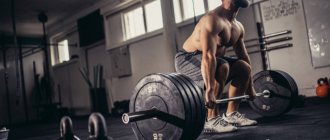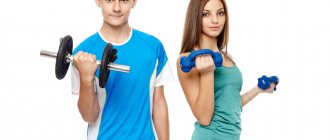It has long been the custom that broad shoulders determine the beauty of a male figure. And this is quite natural, because the wider the shoulders, the narrower the waist, therefore, the athlete’s figure looks as attractive as possible. Shoulder exercises in the gym can be performed using a barbell, and at home, dumbbells are a good choice, with which there are also no less useful exercises than with heavier equipment.
Training shoulders is quite difficult. This is due to their structure. Thus, the deltoid muscle is involved in the formation of the shoulder, which, in turn, consists of three bundles - anterior, middle and posterior. Only with the uniform development of all three components of the deltoid muscle does the shoulder form uniformly. And this has a beneficial effect on the athlete’s figure.
Organization of training
It is preferable to perform basic shoulder exercises that work the entire delta at the same time. If any of the beams lags behind, you need to work on it by doing isolating exercises.
You can train your shoulders both at home and in the gym. But for this you need to have a barbell and dumbbells. The weights must be selected in such a way that in each set it is possible to lift the apparatus 8-10 times. This is how you can increase volume and mass. If the goal is to increase muscle strength, you should train with heavier equipment. In this case, the number of repetitions will be 5-8. Number of sets 4-5.
Beginners are advised to select and perform one or two basic push-ups. Such exercises for the shoulder girdle will allow you to work well and form the deltoid muscle. As you train, you should add several isolating ones, depending on which muscles need additional pumping.
How often should you lift your shoulders?
The shoulder muscles are the same muscles as the rest; with good training, they are fully restored within 7-10 days. Therefore, training a man’s shoulders once a week will be quite enough .
If the training is easy, then you can train the deltoids again after 4-5 days.
Standing barbell press
The standing barbell press, or “military press,” is the main training for the shoulders. Although it affects mainly the middle beam, the other two also actively work.
Initial position:
- Standing. Feet shoulder width apart.
- Take the projectile with a straight grip shoulder-width apart and lift it to chest level.
Technique:
- Raise the projectile upward, exhaling at the end of the lift.
- Pause and slowly inhale, lower the barbell to chest level.
Recommendations:
- Do not work with extreme weight.
- It is recommended to bend your back slightly.
- Alternatively, you can perform this exercise with dumbbells.
Bench press
This is also basic training for developing the shoulder girdle. Performed in a sitting position.
Initial position:
- Sit on a sports bench.
- Bend your back slightly.
- The grip is wide enough.
Technique:
- As you exhale, press the projectile upward. Your arms should be completely straight.
- As you inhale, lower the barbell behind your head.
Recommendations:
- The press should be performed without jerking. Slow and smooth.
- Alternatively, you can perform the exercise by lowering the barbell alternately to your chest and behind your head.
Seated dumbbell press
Many people are interested in how to pump up their shoulders at home. Here is another basic exercise for developing the shoulder girdle. Even if it is not possible to train at home with a barbell, every bodybuilder has dumbbells. So shoulder exercises with dumbbells can be done at home if for some reason you can’t go to the gym.
You can pump up your shoulders at home by doing just this bench press. You just need to put more diligence into it. This does not mean that you need to increase the weight or the number of sets. No, you just need to train regularly.
Initial position:
- Sitting on a bench with a backrest, without arching your back.
- The chin is parallel to the floor, gaze straight ahead.
- Dumbbells are at eye level.
- The elbows are turned to the sides and are strictly under the hands.
Technique:
- As you exhale, powerfully squeeze the dumbbells upward, bringing them together at the top point, without turning your hands.
- At the top point, take a short break.
- As you inhale, smoothly return your arms to their original position.
Recommendations:
- Hands move in the same plane.
- You should not straighten your arms with a jerk at the top point - this has a detrimental effect on the elbow joints!
- It is not recommended to lean back and arch your back.
Anatomy
Before you get acquainted with the best shoulder exercises in the gym, you first need to understand the anatomy of this muscle group. The shoulders (or deltoid muscles) are divided into three bundles:
- Anterior (frontal) deltas. Their main function is to flex the shoulder. As a rule, it is this bundle that is best developed in athletes, since it receives a good indirect load during push-ups and various chest pressing exercises. For this reason, during training, you can spend less time on the front deltoids than the rest.
- Middle (lateral) deltas. The main function is to flex the shoulder and abduct the arms to the sides. The middle delts form the width of our shoulders. This bundle is best worked through isolated exercises.
- Posterior (dorsal) deltoids. The function of this bun is to pull the arms back. They are the hardest to “pump up”. Many athletes ignore this shoulder area, arguing that “it’s behind you and you can’t see it anyway.” If you want to have evenly developed deltoids, you will have to pay attention to this bundle.
Arnold press
This exercise is a variation of the overhead press with dumbbells, but with the starting position of the arms in front of you. The effectiveness of this press is evidenced by the fact that it was a favorite exercise of Arnold Schwarzenegger, who, as you know, reached great heights in bodybuilding. Today, the Arnold Press exercise is a bodybuilding classic.
Initial position:
- Sitting on a bench with a strictly vertical back, pressing your back tightly against it.
- Bend your knees at a right angle, spread them wide and place your feet firmly on the floor.
- Raise the dumbbells to neck level. Bend your elbows at a right angle.
- Turn your hands with your palms facing you.
Technique:
- As you exhale, press the dumbbells vertically upward, while turning your hands with your palms facing outward.
- At the top point, your palms should be facing forward. Take a short break.
- As you inhale, smoothly return the dumbbells to their original position, turning your palms in the reverse order.
Recommendations:
- It is recommended to take lighter dumbbells than usual.
- At the top point, the elbows should not be straightened completely: leave them slightly bent.
- The press is performed smoothly, preferably without a pause at the bottom point. Jerks and accelerations will cause the load to be transferred to the spine.
Tips for beginners
- The main rules to avoid injury during training: adequate weights, correct technique and preliminary warm-up. Be sure to practice your technique before moving on to serious weights.
- Keep your head straight, look straight ahead, without following the bar with your eyes; do not fix your elbows at the extreme points of movement; do not lower the barbell below the level of the end of your neck; keep your wrists in line with your forearms
- After finishing the exercises, take a breather. Lie down, but it's better not to sleep. Take a short walk, slowly. Try not to think about the exercises or the load received. It's better not to think about anything at all.
- Keep a training diary. The diary system itself is designed in such a way that it helps you progress in exercises much faster.
You can read about common mistakes of beginners in sports in the article.
Lateral dumbbell raises
This part of the workout can also be done at home. It is no longer basic, but is aimed at working the lateral surface of the deltoid muscle.
Initial position:
- Stand up straight and lean forward slightly.
- Take dumbbells and lower your arms down.
Technique:
- Take a deep breath. Extend your arms with dumbbells to the sides at shoulder level.
- In the final position, the rear of the projectile should be slightly raised.
- As you exhale, slowly lower your arms back.
Recommendations:
It is necessary to try to eliminate cheating. When thinking about how to properly pump your shoulders, direct the load only to them. Cheating involves other muscles in the work and the results noticeably decrease.
Getting to know the shoulder muscles[edit | edit code]
Main articles:
Muscles of the shoulder girdle and Muscles of the arms Posterior group of shoulder muscles
Officially, the shoulder muscles are called deltoides.
, or
deltoid
. They are like two caps covering both of your shoulder joints from above (the best way to see them is to stretch your arm horizontally). If we talk about the structure, then the deltoid consists of three parts.
- Central.
The upper, or middle, deltoid muscle is located at the top of the shoulder. When it contracts, you are able to raise your arm.
- Front.
This deltoid muscle is located in front of the shoulder. When it contracts, the hand moves inward, towards the center of the chest.
- Rear.
When this deltoid muscle, located behind the shoulder, contracts, the arm returns to its normal position and may even move back a little.
Your shoulders are able to move in different directions due to the presence of ball-and-socket joints
. The round head of the humerus sits tightly in the joint capsule, free to rotate as you need. There is another pair of these ball-and-socket joints between your pelvis and hips, but it doesn't have the mobility of your shoulders.
Shoulder Rotators
is a group of four muscles that prevent the shoulder bones from slipping out of the socket. They pass below the deltoids, quietly doing their job. Unfortunately, shoulder rotators are so subtle that many people don't even know they exist and therefore don't bother training them. Typically, we only find out about them when a professional baseball player is sidelined for an entire season due to their injury. The rotator cuff muscles stabilize the shoulder joint and allow you to rotate your arm without bending your elbow, such as when you rotate your palm forward and then back. They also come into play when throwing and raising your arms above your head.
Bent over side dumbbell raises
This is an isolation exercise that works the back of the deltoids.
Initial position:
- Stand up straight, take the projectile in your hands and lean forward at an angle of 45 degrees.
- Lower your hands with dumbbells down.
Technique:
- Take a deep breath. Raise the dumbbells to the sides, trying to lift them as high as possible.
- Smoothly return your hands to the starting position while exhaling.
Recommendations:
- At the end point of the exercise, the front of the dumbbells should be slightly tilted forward.
- Keep your back straight, slightly arched at the lower back. Rounding your back can cause injury.
How many sets and reps should you do?
We have presented to your attention shoulder exercises for men. But the question arises: how to combine them all into one training program? Let's say right away that you don't need to do all of these exercises in one workout. It is enough to choose three movements: one basic and two isolating. In the first, you will work the front and middle deltoids (for example, bench press), in the second - only the middle ones (standing dumbbell flyes), and in the third - the rear ones (bent over dumbbell flyes). If your goal is to gain muscle mass, then do 3-6 sets of 6-12 reps each for each exercise.
Barbell row to the chin
Basic exercise for working the deltoid muscles, mainly the middle fascicle. The trapezius muscles are also involved.
Initial position:
- Stand up straight. The shell is below.
- The grip is straight. The distance between the hands is approximately two fists.
Technique:
- As you exhale, raise the barbell to your chin.
- Hold the projectile in the upper position.
- As you inhale, return the bar to its starting position.
Recommendations:
- Elbows should always be spread out to the sides and raised vertically.
- Keep your back and neck straight, chin horizontal.
- The bar of the bar should rise exactly to the chin, that is, above the shoulders.
- The weight of the barbell should not be an obstacle to proper exercise technique.
Types of shoulder exercises in the gym
In total, exercises for working out the shoulders can be divided into two types:
- Presses (basic movements for shoulder mass).
- Swings (isolated movements aimed at working out a specific bunch of deltas).
Typically, heavy pressing movements are done at the beginning of shoulder training. Swing exercises are performed at the end in order to “finish off” already tired muscles. This approach has two advantages: firstly, at the beginning of the training session you have a sufficient reserve of strength for the most difficult exercises. And secondly, swings are more dangerous. Since at the end of the workout their working weight will be light, it is better to finish shoulder training in the gym with these movements.
